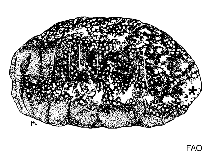Holothuria pulla Selenka, 1867
Google image | No image available for this species;
drawing shows typical species in Holothuriidae.
Classification / Names Κοινά ονόματα | Συνώνυμα | CoL | ITIS | WoRMS
Holothuroidea | Holothuriida | Holothuriidae
Environment: milieu / climate zone / εύρος βάθους / distribution range Οικολογία
; εύρος βάθους ? - 20 m (Αναφ. 81020). Tropical
Distribution Χώρες | Περιοχές FAO | Οικοσυστήματα | Παρουσίες | Εισαγωγές
Indo-West Pacific.
Length at first maturity / Μέγεθος / Weight / Age
Γεννητική Ωρίμανση: Lm ? range ? - ? cm
Life cycle and mating behavior Γεννητική Ωρίμανση | Αναπαραγωγή | Γεννοβολία | Eggs | Γονιμότητα | Larvae
Main reference
Αναφορές | Συντονιστής | Συνεργάτες
UNEP-WCMC 2003 UNEP-WCMC Species Database. http://www.unep-wcmc.org. (Αναφ. 485)
IUCN Red List Status
(Αναφ. 130435: Version 2025-1)
CITES status (Αναφ. 108899)
CMS (Αναφ. 116361)
Threat to humans
Human uses
| FishSource |
Εργαλεία
Περισσότερες πληροφορίες
Σύσταση δίαιτας
Κατανάλωση τροφής
Θηρευτές
Διαδικτυακές πηγές
BHL | BOLD Systems | CISTI | DiscoverLife | FAO(Publication : search) | Fishipedia | GenBank (genome, nucleotide) | GloBI | Gomexsi | Google Books | Google Scholar | Google | PubMed | Δέντρο Ζωής | Wikipedia (Go, αναζήτηση) | Zoological Record



